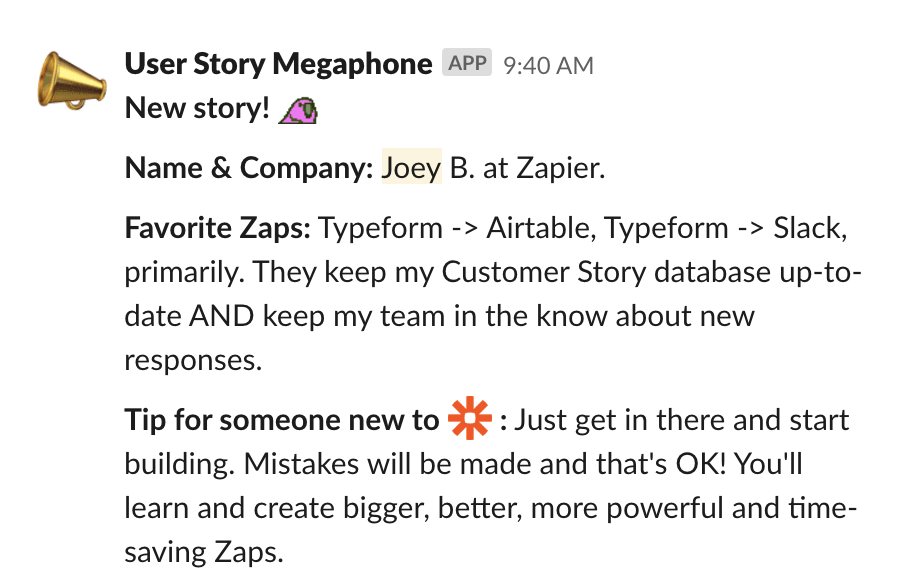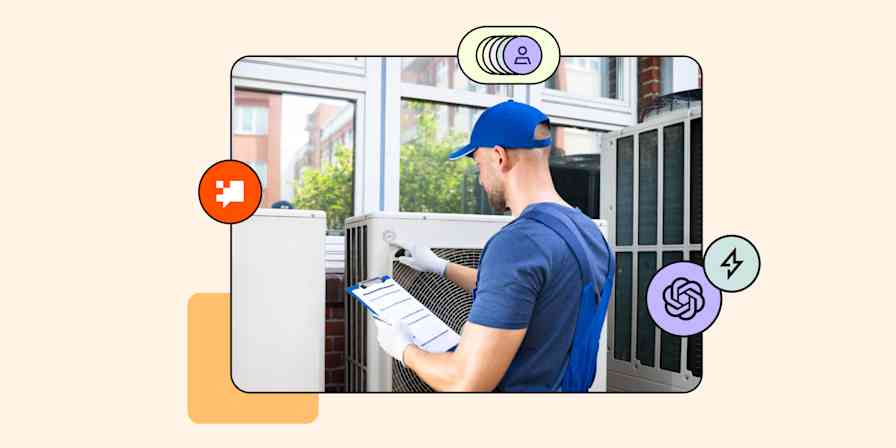As Zapier's customer storyteller, discovering how our users automate their work, and then writing about it and sharing their success, is at the heart of my work.
And at the heart of my process is a questionnaire I built on Typeform. When one of Zapier's customer champions encounters someone who's excited about their Zaps, our word for an automated process connecting two or more apps, or we find an interesting brand, we send them this form.
By filling out the typeform, Zapier's customers provide me with a ton of information—most importantly, I can find an angle to turn a workflow into a story—something that other Zapier customers or potential customers can gain inspiration from. So far, this process has helped me share stories with all of you about how to manage task creation, add leads to a CRM, and update a customer spreadsheet, from companies like Intercom and Indiegogo.
But how does a response from a typeform become a fully-fledged and published story? Well, it involves a multi-step Zap I built with Paths, Zapier's conditional logic app.
So what are Paths? Let's say you have a form that collects pastry orders. If someone selects a cake, you send a specific email with a specific cake gif. If they select pie, though, they need to get a different email with a different gif. With Paths, you can do all that in one Zap.
It's how I'm able to take a response to a typeform and end up with a story. I'll break it down into its pieces and you'll see that just because there's a high step count doesn't mean it's a complex Zap. In fact, it's pretty simple. So let's get into it.
Zapier's Customer Storyteller's Tools
Icon: | App: | Used For: |
|---|---|---|
Survey results | ||
Customizable spreadsheet & database | ||
Lead enrichment |
Sending Typeform Responses to Airtable and Slack
This first step is straightforward enough: At Zapier, we have a user story database in Airtable where we house all the customer responses we've received throughout the years. Questions have changed or been added and removed, but this Airtable features the lot of them.
In here, teammates across the Editorial and Product Marketing teams, as well as UX Research and Comms, can peruse the information to find quotable quotes or reach out to folks with interesting stories to continue the conversation as well as immediately write up stories.
At the same time this Zap updates Airtable, it also sends a message to a channel in Slack. This message lets us know we received another response, who it's from and what company they work for. It also shares a few of their responses, like their favorite Zaps.

This helps us in a few ways: The most obvious way is the response feed it creates in Slack. Our Partnerships team can use what comes in to pitch co-marketing efforts, and Comms might find a new customer to mention in an article.
It also shares positivity with the company at-large. It's easy to find yourself caught up in your own tasks on especially busy days, so these responses offer up an opportunity to poke our heads above the grass to see the landscape.
You can try these pieces yourself to automatically create a response database and keep your team informed—I have no doubt they'll benefit you as much as they have me:
Enrich the Responses with Data from Clearbit
Once the Zap notifies our team of new responses and it's recorded in our Airtable database, we get to the nitty-gritty: adding information about the customer. For this, I use Clearbit, a lead enrichment app.
In this case, you can consider the customer as the lead, even though I'm not trying to sell them anything. Using information gathered by the typeform, I have Clearbit look up the customer's business.
I'm curious about a few things: First, how big is this company in terms of employees? What country are they based in? What's their industry? And what's their Alexa rank?
It's at this step that Paths come into play. The Alexa rank is a calculation of page views and daily visitors over the course of 3 months, and it can be used as a rough gauge of a business's popularity, reach, and brand awareness. And Clearbit returns two ranks: a US rank and a Global one.
This is where my Paths diverge. If there is no US rank, I have one Path add the Global rank to an Airtable column with an asterisk, so I know it's not the US. If there is a US rank, the other Path adds that rank to the same column, but without the asterisk. I do this in order to understand the potential reach of a brand—one with a lower US rank (1 is the best possible, currently held by Google) means a story with that brand could have more impact than one without a US rank and a higher rank.
It's a small divergence, but I used to have to create separate Zaps to do this. Housing it all under one helps me stay organized.
Enrich leads from Typeform responses with Clearbit and add the information to Airtable
Now that I have extra information, the Zap updates Airtable to include company size, Alexa rank, industry, and whatever else I find in Clearbit that's helpful or interesting. And with this information, I can sort the responses I get by Alexa rank or company size. It gives me an even fuller picture of the information I initially receive from Typeform.
Pretty simple, right? It all starts with Typeform and an easy-to-edit/adjust/tweak form. And the end result is a thorough, detailed database in Airtable that makes my work sourcing stories a breeze. Without the information my typeform gathers, I'm just a writer. But with Typeform, I'm a Customer Storyteller.
Want to take your processes to the next level? Give Zapier a try for free.
What's your story? Tell us how you use Zapier to do more. You can also read even more customer stories and find new ways to improve your workflow and productivity.








